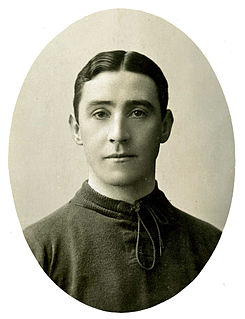
Total Football is a tactical system in association football in which any outfield player can take over the role of any other player in a team. Although Dutch club Ajax and the Netherlands national football team are generally credited with creating this system during the 1970s, there were other sides who had played a similar style before, such as the Austrian Wunderteam of the 1930s, English club Sunderland in the mid-1930s, the Argentine side "La Maquina" of River Plate in the 1940s, the Golden Team of Hungary in the 1950s, English team Burnley in the late 1950s and early 1960s, and Brazilian side Santos in the 1960s.

Michael Laudrup is a Danish professional football coach and former player. He is considered to be one of the greatest players of all time. He is the older brother of fellow retired footballer Brian Laudrup.
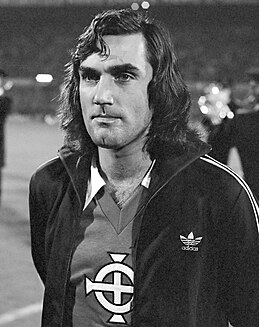
George Best was a Northern Irish professional footballer who played as a winger, spending most of his club career at Manchester United. A highly skilful dribbler, Best is regarded as one of the best players in the history of the sport. He was named European Footballer of the Year in 1968 and came fifth in the FIFA Player of the Century vote. Best received plaudits for his playing style, which combined pace, skill, balance, feints, two-footedness, goalscoring and the ability to get past defenders.

Forwards are outfield positions in an association football team who play the furthest up the pitch and are therefore most responsible for scoring goals as well as assisting them. As with any attacking player, the role of the Forward relies heavily on being able to create space for attack.

Romário de Souza Faria, known simply as Romário, is a Brazilian politician who previously achieved worldwide fame as a professional footballer. A prolific striker renowned for his clinical finishing, he scored over 750 goals and was the first player to score at least 100 goals for three different clubs. He is considered one of the greatest players of all time. Romário starred for Brazil in their 1994 FIFA World Cup triumph, receiving the Golden Ball as player of the tournament. He was named FIFA World Player of the Year the same year. He came fifth in the FIFA Player of the Century internet poll in 1999, was elected to the FIFA World Cup Dream Team in 2002, and was named in the FIFA 100 list of the world's greatest living players in 2004.
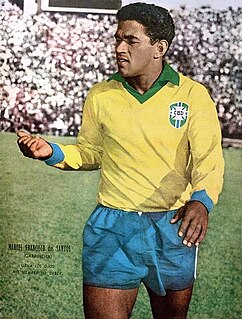
Manuel Francisco dos Santos, nicknamed Mané Garrincha, best known as simply Garrincha, was a Brazilian professional footballer who played as a right winger. He is widely regarded as one of the greatest players of all time, and by some, the greatest dribbler ever.

Marinus Jacobus Hendricus Michels was a Dutch football player and coach. He played his entire career for AFC Ajax, which he later managed, and played for and later managed the Netherlands national team. He is regarded as one of the greatest managers of all-time.
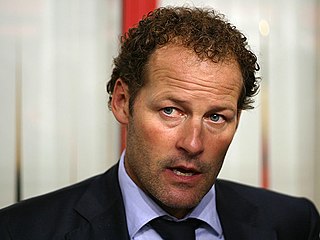
Dirk Franciscus "Danny" Blind is a former Dutch international football player and coach. He played as a defender for Sparta Rotterdam, Ajax and the Netherlands national team.
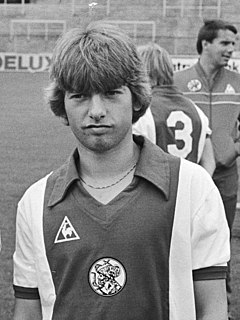
Jesper Olsen is a Danish former footballer who played for Ajax of the Netherlands and Manchester United of England. Olsen was a regular left winger for the Danish national team, scoring five goals in 43 matches. He represented Denmark at the Euro 1984 and 1986 World Cup tournaments.
In sports, dribbling is maneuvering a ball by one player while moving in a given direction, avoiding defenders' attempts to intercept the ball. A successful dribble will bring the ball past defenders legally and create opportunities to score.
In association football, rugby league, rugby union and Australian rules football, a dummy or feint is a player deceiving the opposition into believing he is going to pass, shoot, move in a certain direction, or receive the ball and instead doing something entirely different, thus gaining an advantage.
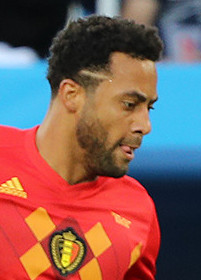
Mousa Sidi Yaya Dembélé is a Belgian former professional footballer who played as a central midfielder. He was regarded as one of the best box-to-box midfielders in Europe due to his excellent dribbling skills and ability to maintain possession.

The Netherlands national football team has represented the Netherlands in international men's football matches since 1905. The men's national team is controlled by the Royal Dutch Football Association (KNVB), the governing body for football in the Netherlands, which is a part of UEFA, and under the jurisdiction of FIFA. They are widely considered one of the best national teams in world football and widely regarded as one of the greatest national teams of all time.Most of the Netherlands' home matches are played at the Johan Cruyff Arena, De Kuip, Philips Stadion and De Grolsch Veste.
The Marseille turn, also known as the 360, the Spin, the Mooresy Roulette, the Roulette, the Girosflin, and the double drag-back, is a specialised dribbling skill unique to the game of Association football. With so many different names, the exact origin of this skill move is unknown. The Marseille turn was first popularized in Europe by French striker Yves Mariot in the 1970s. Diego Maradona and Zinedine Zidane were arguably the most notable exponents of the move, and thus it has also been known as the Maradona turn and the Zidane turn.

Jan "Janne" Olsson is a Swedish former footballer who played mostly as a defender.
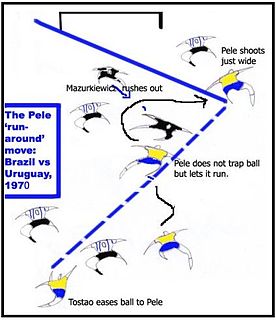
The Pelé runaround move is a football move designed to get around an opponent. The move requires split-second timing and speed in execution – letting a pass from a teammate approach but allowing it run past the opponent, then sprinting around the opposing player to continue the attack. It relies on speed for its execution in situations where there is little time or space.

Hendrik Johannes Cruijff was a Dutch professional football player and manager. As a player, he won the Ballon d'Or three times, in 1971, 1973 and 1974. Cruyff was a proponent of the football philosophy known as Total Football explored by Rinus Michels. He is widely regarded as one of the greatest players in the history of the sport, as well as one of its best managers ever. He is also considered to be one of the most influential figures in modern football.

The flip flap is a dribbling move, or feint, in football, used to fool a defensive player into thinking the offensive player, in possession of the ball, is going to move in a direction they do not intend to. Players perform it by using the outside of their dominant foot to push the ball towards their dominant side, then quickly move the dominant foot around the ball and using the inside to push the ball to their non-dominant side. Although the footwork is the most distinctive aspect of the flip-flap, its success as a feint also relies heavily on the attacking player having an explosive acceleration from a stationary position.

Sam Andreas Larsson is a Swedish professional footballer who plays as a winger for Süper Lig club Antalyaspor and the Sweden national team.
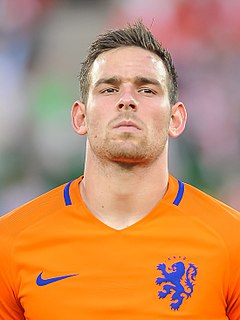
Vincent Petrus Anna Sebastiaan Janssen is a Dutch professional footballer who plays as a forward for Royal Antwerp and the Netherlands national team.


















